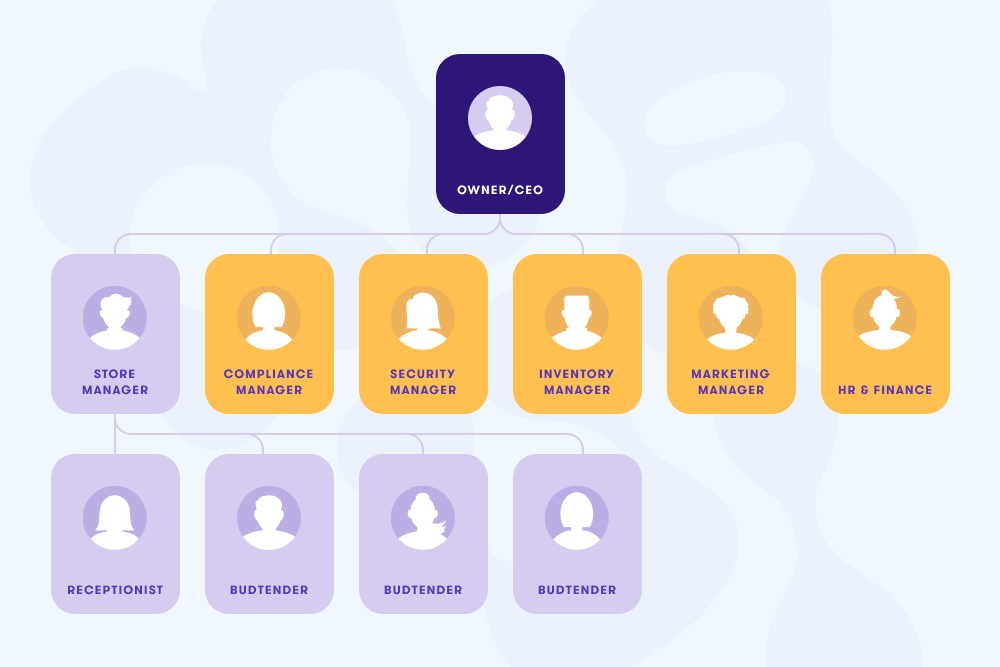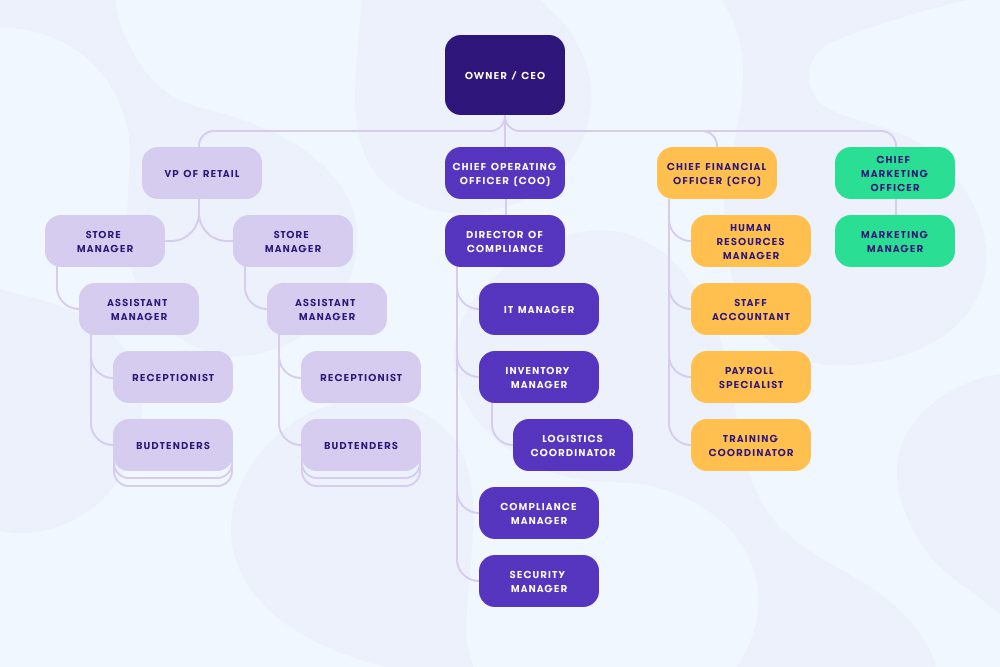Every dispensary needs a documented organization chart to understand who does what within the company, and how all these roles work together.
How your dispensary org chart looks depends on many factors, and no two will be exactly the same. Your size, number of stores, the skills of your employees, and your plans for growth will impact your org structure.
In this post, we’ll briefly discuss what a dispensary org chart is, why you need one, and then show sample org charts for single-location operations vs. multi-location cannabis businesses so you can build your own chart with confidence.
What is a dispensary org chart?
A dispensary org chart is a visual representation of the hierarchy and structure of a cannabis retail business. It outlines the various roles, positions, and reporting relationships within an organization.
An org chart typically looks like this:
Top-level management - often a CEO or owner.
Department heads - such as dispensary manager, head grower, etc.
Roles within each department - including assistant manager, lead budtender, supervisors, inventory staff, security, marketing specialists, etc.
One primary benefit of an organizational chart is that all team members can see how their role relates to every other role within the company, including seniority and layers of authority. This transparency helps with overall job satisfaction and reduces employee turnover.
Why you need a dispensary org chart
It’s easy to overlook the need for a documented cannabis org chart, but having one is vital to your dispensary's success. Whether it’s a team of five, or 500, everyone needs to know the structure and hierarchy of the company.
Overall, a dispensary org chart is essential for organizing your staff, establishing reporting lines, clarifying roles, and promoting effective communication within your cannabis retail business.
It contributes to efficient operations, especially as you grow and expand.
Beyond the structure of the company, and what jobs exist within it, are the people. An effective org chart is continually updated to show who, specifically, fills those spaces.
There are two common dispensary org chart models:
Centralized model - Has layers of hierarchy with those at the top having authority to make decisions and set policies/priorities for the groups below them. This model is pyramid-shaped and is common for larger dispensary brands.
Decentralized model - Often called a flat org structure, this model is flatter and leaner, where even staff at lower levels of the chart have some authority and there are fewer people at the top setting direction. This is often seen in smaller companies and single-store operations.
Dispensary org charts not only show you where you are; they can be used to show where you’re going.
Pro tip! If you’re a dispensary owner or CEO, create one org chart to show where you’re currently at, and who does what today. But also create an “ideal” or “blue sky” org chart that shows where you want to go, and the roles you’ll need to expand into and fill to get you there. This not only helps visualize your growth, but helps understand future resourcing requirements.
Sample dispensary org chart: Single-location
The organizational chart for dispensaries and cannabis brands will vary considerably based on size and scale.
For dispensary brands with one location, here’s what an org chart may look like:

Every operation will look different, but there are a few basic roles that must be filled within a single-location cannabis dispensary.
In smaller operations, it’s common to have one person play several roles, or have ownership of various operational functions. You may not have a unique person for all these roles, but they will all need to be covered by your staff at all times.
CEO/founder/owner - the primary person in charge and decision-maker.
Dispensary manager/supervisor - oversees the day-to-day operations, ensures customer satisfaction, manages staff, and addresses any operational challenges that may arise.
Compliance manager or specialist/legal - ensures adherence to local and state regulations, licensing requirements, and compliance with cannabis-specific laws.
Security manager - oversees the implementation of security protocols, video surveillance, access control, and prevention of theft or diversion.
Budtenders/patient consultants/cashiers - engages directly with customers, provides guidance, and ensures a positive experience.
Receptionists/intake specialists - greets customers, oversees the waiting room, and ensures all customers are checked in based on state requirements.
Inventory manager/supply chain coordinator - maintains accurate inventory records, manages stock levels, tracks product expiration dates, and coordinates orders with suppliers.
Marketing manager/social media specialist - develops marketing campaigns, manages online presence, and creates brand awareness.
Training manager/educator - trains new and existing employees and ensures adherence to standard operating procedures.
Administrative staff/office manager - ensures the office and business run smoothly, handing mail/packages, staffing, and other duties as assigned.
HR/payroll/accounting - oversee all financial and human resource tasks like onboarding, payroll, and bookkeeping.
Delivery coordinator/driver (if applicable) - oversees the process of delivering cannabis, including staffing, procedures, managing delivery orders, and making deliveries.
Note: The roles above are specific to the retail part of a cannabis business. If you are vertically-integrated, be sure to add your department leads and specific roles for cultivation, extraction, manufacturing, and transportation to your org chart.
Read next!
Must-have Dispensary Staff
Sample dispensary org chart: Multi-location
Once you add stores, or locations, the basic structure of your dispensary’s org chart will expand.
For cannabis retailers with 2+ locations, here’s what the org chart may look like:

You’ll notice that common additions include more leadership, like a chief operating officer (COO) to oversee the operational functions of the business, like compliance and security, and having dedicated accounting, payroll, and human resource roles.
The reason for the additions is as the business grows — more stores, more resources (including human), and more money coming in and going out — you need more people to oversee everything. For example, adding leadership creates a clearer strategic focus. And adding specialties, like building out a marketing team, happen as the workloads on the existing lean team become impossible to manage.
Some companies outsource a few of these roles, such as hiring a marketing agency, independent finance professionals, or cannabis IT consultants. There are pros and cons to outsourcing vs. hiring full-time staff, and those factors will change as your dispensary brand grows.
You’ll also have store-level staff per location to account for, and will need oversight of all stores, like a VP of retail, and/or state or district-level store leadership.
In addition to the roles listed for single-location dispensaries, multi-location businesses may also include:
Regional manager(s)/district manager(s) - oversee a grouping of stores and supervise the store (or general) manager at each location.
Director of operations - oversees the operations of all stores, including technology.
Director of retail - oversees the customer experience of all stores, including front-line staff.
Inventory manager/supply chain director - oversees inventory managers at all locations, manages company-wide vendor relations/contracts, and oversees inventory reporting.
Logistics coordinator - ensures the movement of products to other stores as necessary.
Compliance director - oversees regulatory compliance at the company level and manages compliance for new store openings and entering new markets.
Marketing director - oversees marketing efforts for the overall company brand, plus activations/events/partnerships at the local store level.
HR director/manager - oversees hiring, benefits, training, etc. for all employees.
Finance director/manager - oversees the finances for the entire company and works with store-level staff to manage revenue and expenses.
IT director/manager - oversees technology, both within all stores, and at the company level.
Tips for establishing organizational structure
First and foremost, remember that every business’ org chart will be different. Even single-store operations will vary by size, layout of the store, and daily workflows like whether you do delivery or are vertically-integrated.
Here’s some other tips to remember as you build your dispensary org chart:
Define your business objectives: Before creating your org chart, define your business objectives and goals. Then understand the core functions or departments necessary to achieve those objectives. This will provide a foundation for the organizational structure.
Start with the basics: Begin by identifying which essential roles and positions are critical for day-to-day operations, like CEO, CFO, COO, and other key leadership roles. Then consider the primary functional areas like front-line store staff, inventory, finance, and operations.
Consider scalability: While designing the org chart, think about future growth and scalability of your business. Anticipate the need for additional positions or departments as your business expands. If you plan to add or aqcuire more stores quickly, plan for the necessary team now.
Determine reporting relationships: Determine the reporting lines and hierarchies within the organization. Consider who will be reporting to whom and think about how information will flow within the organization. Many roles could report through several different areas; look at the actual team and their experience/skill sets when building out reporting structures.
Clarify roles and responsibilities: Clearly define the roles and responsibilities associated with each position in the org chart. This will help employees understand their duties and minimize confusion or overlap.
Involve key stakeholders: Seek input from key teammates such as department heads, managers, and other employees who have a good understanding of the organization's operations. Their insights can provide valuable perspective and ensure that the org chart accurately reflects the current and desired structure.
Keep it simple: A well-designed org chart should be easy to understand and navigate. Use clear job titles and concise descriptions for each role. Avoid overcrowding the chart with excessive levels or too much detail.
Update and adapt: Org charts are not static. The document should evolve as your team grows and changes. Regularly review and update the org chart to reflect any structural or personnel changes. Communicate these updates to your team to maintain transparency and clarity.
Make it available: All staff should see the org chart and know where to find it.
Chart your path to dispensary success
Having a documented organizational structure for your cannabis business is a necessity, especially as you plan to expand. Org charts highlight the people — and their roles — within your company and visually represent how all the roles and responsibilities relate to each other.
As you build out your dispensary's organizational chart, be sure to create clear job descriptions for each role as well. You can download these job description templates to streamline this process.




